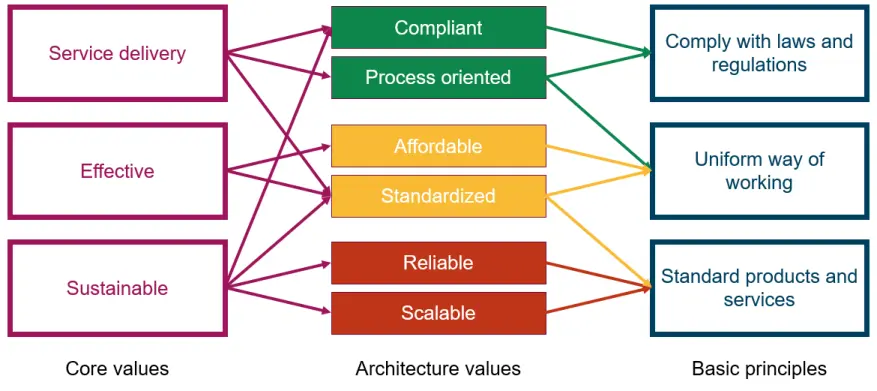Values are a core part of how an organization operates. Making architectural decisions based on these values creates a value-driven architecture.
Value-driven architecture is an approach to designing and implementing architectural solutions for systems and software that prioritizes delivering value to stakeholders. It places an emphasis on aligning architectural decisions with the goals and objectives of the business or organization.
Creating a value-driven architecture is relatively simple compared to the more extensive strategy to execution journey. Value-driven architecture starts with the core values of an organization and translates them into architectural values.
Core values
An organization’s core values are short, usually one-word phrases that describe what the organization values; what the organization stands for.
Core values are the principles and priorities that guide an organization’s actions. They represent the foundational commitments and deeply held beliefs that allow a company to navigate complex situations while keeping their identity and culture at the forefront.
Core values define the way an organization operates and form the skeleton upon which a strategy is built. Core values are therefore an important piece of information for Enterprise Architecture to consider and work with.
The primary goal of value-driven architecture is to deliver value to the business or organization. As a result, architectural decisions are made with a clear understanding of how they impact the bottom line and support business goals.
Architecture values
To achieve value-driven architecture, it is necessary to translate an organization’s core values into architecture values. Defining architecture values is an exercise that yields the best results when collaboration is sought with an organization’s senior management and other relevant stakeholders. The goal in formulating architecture values is to get all stakeholders around the table and have them formulate the values. In this way, the values are not determined solely from an architectural perspective, but are broadly supported by the organization.
An example
To give an example of how this process might unfold, the figure below has been created. As can be seen in the figure, it shows the process that can be followed to translate an organization’s core values into architectural values and, ultimately, principles and guidelines (requirements).
The figure shows the core values of a fictitious organization (left column). The core values are then translated into and related to architecture values (middle column), and ultimately result in a set of basic principles (right column).

The fictional organization recognizes three core values.
- Service delivery
- Effective
- Sustainable
The first of the core values, Service delivery, can be translated into the architecture values Compliant, Process oriented, and Standardized. The core value Effective can be related to the architecture values Affordable and Standardized, and the core value Sustainable can be easily translated to the architecture values Compliant, Standardized, Reliable, and Scalable. The figure shows that the Compliant and Standardized architecture values are related to more than one core value. This is not surprising, since some architecture values simply apply to more than one core value.
The trick to formulating architecture values is to keep them as simple as possible and not get bogged down in a plethora of values. Try to limit the number of architecture values to no more than three per core value. If more architecture values are identified during the stakeholder session(s), select the most important ones or merge related values.
Basic principles
Once the architectural values have been formulated, they can be used to define a set of basic principles. By looking closely at the themes of the architectural values, it is possible to distill basic principles from them. For example, the green colored architectural values in the image above indicate a relationship with laws and regulations. The yellow values relate to a way of working, and the dark orange values relate to products and services.
Based on these themes, three basic principles can be established.
- Comply with laws and regulations
- Consistent way of working
- Standard products and services
The formulated set of principles can be further translated into applicable requirements and possibly standards. Since requirements and standards are largely dependent on the type of organization, they are not included in the illustration above.
Closing remarks
Value-driven architecture aims to ensure that architectural decisions are not made in isolation but are closely aligned with the evolving needs of the business or organization. It promotes a more responsive approach to system and software architecture, thus leading to greater satisfaction and success for all stakeholders.
Creating a value-driven architecture is not very complex and can be formalized in a relatively short time. It also provides a relatively solid basis for creating principles, supplemented by requirements and standards. This can be a good starting point for getting architecture work off the ground.
Do you agree with my ideas about value-driven architecture? Or not at all? Let me know in the comments below.







Leave a Reply